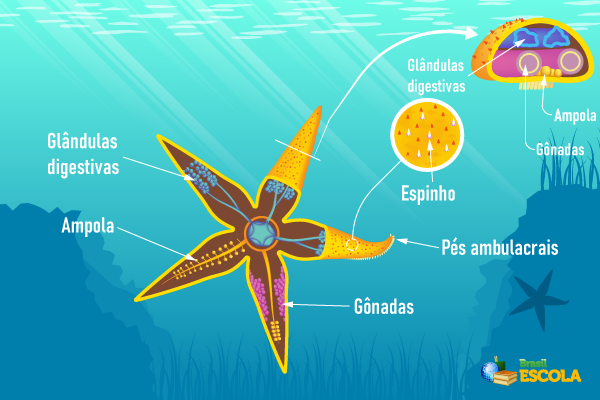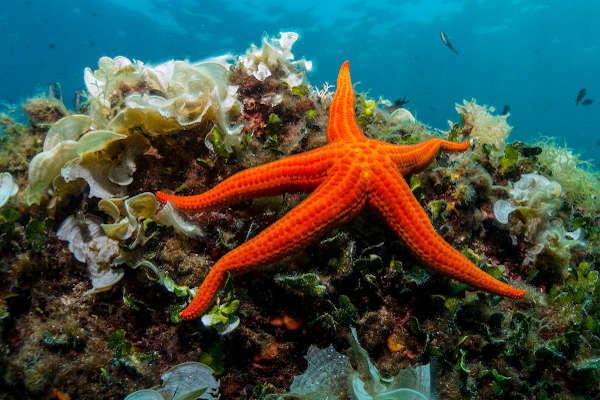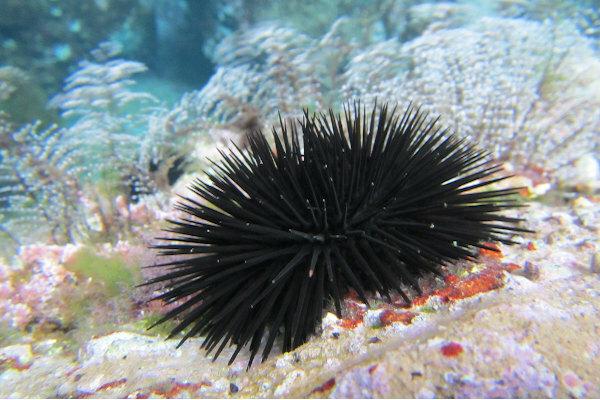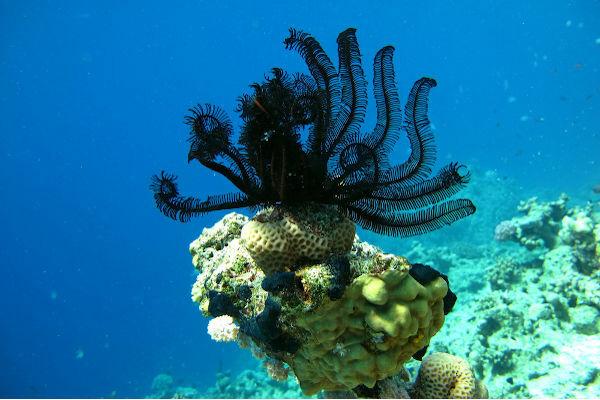echinoderms (Phylum Echinodermata) they are animals that live in the marine environment and stand out because their representatives, in their majority, present a body full of thorns or pointed projections. This characteristic was used to name the group, the term echinoderm being derived from the Greek — echin, which means "covered with thorns", and dermis, which means "skin".
The echinoderms are organisms triblastic, coelom and deuterostomy. This last feature makes them more related to the phylum of the chords than with the other groups of invertebrate animals. Another striking feature in echinoderms is the presence of an aquifer vascular system, also called the ambulatory system.
Read too: Classification of marine environments
General characteristics of echinoderms
Echinoderms are animals that live exclusively in the marine environment. They are slow moving, with some species being sessile. do not form colonies there aren't even species parasites. Currently, about 7000 different species of echinoderms, among which we can highlight the sea stars, beach biscuits and sea cucumbers.

Echinoderms are animals that mostly have prickly or verrucous appearance. present a endoskeleton (Internal skeleton) formed by limestone plates, from which thorns or sharp projections often depart. The endoskeleton is covered by a thin epidermis.
These animals have no head, therefore, its body does not have an anterior and posterior region, it is organized in an oral-aboral axis, the oral portion being the region of the mouth and the aboral portion the region opposite to it.
Do not stop now... There's more after the advertising ;)
The representatives of the echinoderms are organisms triblastic, that is, they have three embryonic leaflets: ectoderm, mesoderm and endoderm. In addition, they have coelom(body cavity covered by tissue derived from the mesoderm) and healthy deuterostomes (blastopore gives rise to anus). The symmetry in these animals is different in the adult phase and in the larval phase. while the larvae have bilateral symmetry, in adults, the symmetry is radial.
O digestive system is complete in most species, the wildebeest being an exception. A curiosity about starfish is that they are able to throw the stomach out of the body and release digestive juices on their prey, initiating digestion externally. Afterwards, these animals collect their stomach, with the pre-digested food, and finish the digestion.
the echinoderms they do not have a specialized excretion system or a typical circulatory system., being the transport of substances through channels inside the coelom. Breathing is done by diffusion by the outpatient system, in some species, and by gills, in others. In holoturoids, the so-called respiratory tree, which is close to the cloaca and ensures gas exchange in these animals.
O nervous system, in turn, consists of a nerve ring from which radial nerves exit. These animals have separate sexes, external fertilization and indirect development, with emergence of larvae.
Read too: Porifers - characteristics, physiology and reproduction
Ambulatory system or aquifer vascular system
The ambulatory system, also known as the aquifer vascular system and the hydrovascular system, is exclusive of echinoderms. It consists of a network of channels filled with a fluid similar to sea water, which is distinguished by having cells, proteins and potassium ions. These channels branch through the animal's body and have extensions called ambulatory feet. This system is related to several processes, such as feeding and locomotion.
In starfish, it is observed that this system is constituted by the madreporito or madreporic plaque (place where water flows into and out of the echinoderm's ambulatory system), which communicates with the circular channel through a stone channel. From the circular channel, located in the animal's central disc, the radial channels, that extend through the arms of the starfish. From the radial channels the side channels, which have a valve and end in a ampoule it is a ambulatory foot.
To ensure movement, the ambulatory system behaves like a hydraulic system. The ambulatory foot elongates when the ampoule contracts, and water is forced into it and retracts when the muscles in the feet contract and force the water back into the ampoule. Ambulatory feet, when they stretch, come into contact with the substrate and secrete chemical substances that allow them to adhere to the site. To release, non-stick substances are secreted.
Classification of echinoderms
The echinoderms can be divided into five classes: asteroid (starfish), Ophiuroidea (snake stars), Echinoid (sea urchins and beach biscuits), Holothuroidea (sea cucumbers) and crinoid (sea lilies).

- asteroid: in this group we have the famous starfish, which have a central disc and arms. Typically, starfish have five arms, but some species can have up to 40. An important feature of these animals is their great regeneration capacity. Through a single arm, for example, stars are able to regenerate their entire body as long as part of the central disc remains attached to that arm.

- Ophiuroidea: these animals have a central disc from which long, flexible arms depart. Its movement occurs, mainly, by the action of its arms, which make movements like a snake.

- Echinoid: in this group are members with rounded body (sea urchin) and flat body (beach biscuits). They do not have arms, like other echinoderms. The ambulatory feet are arranged in five rows that allow these animals to move slowly. A striking feature in this group is the call Aristotle's lantern, a scraper device present in sea urchins that is characterized by the presence of five limestone plates.

- Holothuroidea: it is one of the most distinct groups of echinoderms. In these animals the endoskeleton is reduced and their body is elongated. They have five rows of ambulatory feet, and some of these structures are modified like tentacles around the mouth, helping these animals to feed.

- crinoid: are echinoderms that resemble small plants. Some representatives of this group live attached to the substrate (sea lilies), while others manage to crawl using their arms (sea feathers). The mouth of the crinoids is turned upwards, towards a region away from the substrate. This class stands out because its representatives have a morphology that has changed little over time. Many fossils, from around 500 million years ago, show the similarity of these individuals to species that lived in the past.
By Vanessa Sardinha dos Santos
Biology teacher
